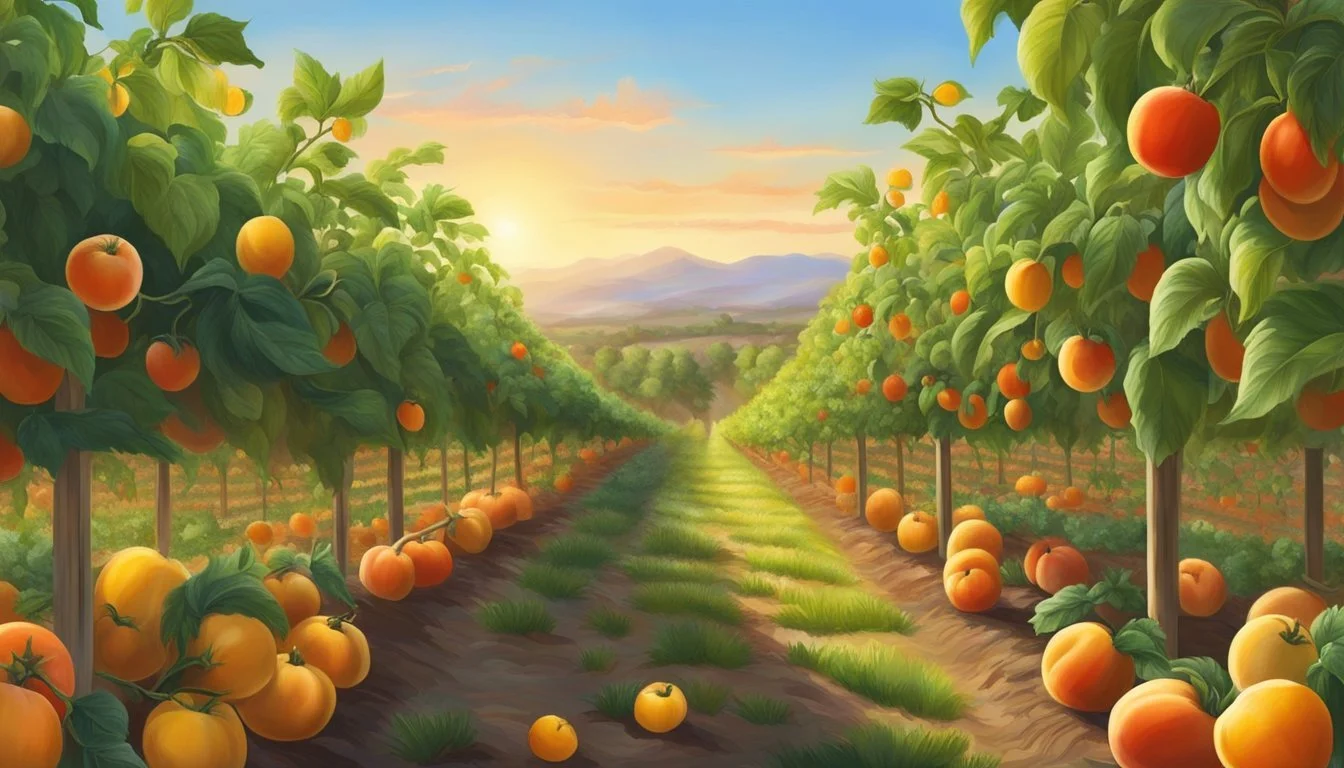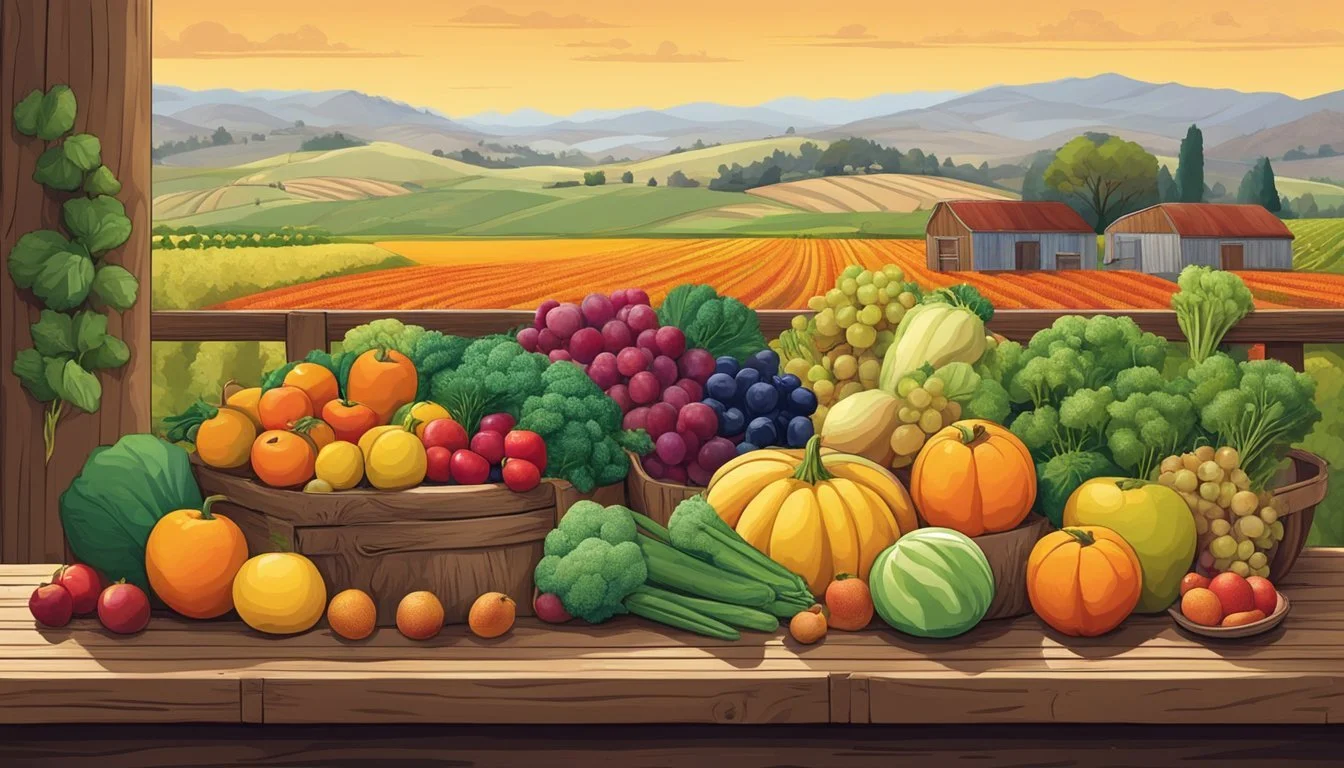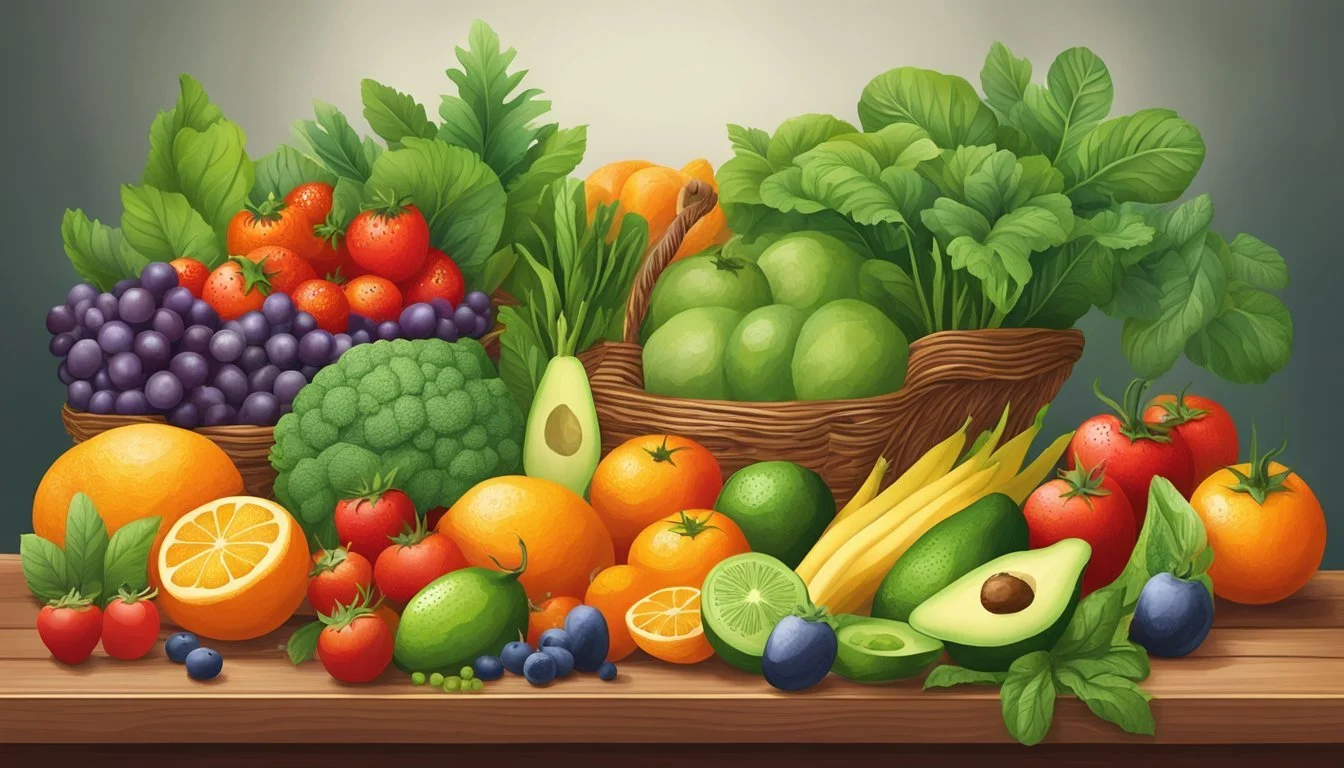California Seasonal Fruit & Veg Guide
Your Ultimate Season-By-Season Primer
California stands as a vibrant hub for a diverse range of produce, owing much to its unique climates and extended growing seasons. Farms across the state diligently work year-round to cultivate an array of fruits and vegetables, aligning with the philosophies of the farm to table movement. This guide is deeply rooted in the rhythms of the seasons, providing a knowledgeable compass for navigating the freshest and most delectable produce available throughout the year.
Embarking on a seasonal journey through California's agricultural landscape reveals a bounty of produce at its peak. In each season, certain fruits and vegetables come to the forefront with unmatched flavor and nutritional value. Consumers who are privy to these cycles can indulge in the freshest artichokes (how long do artichokes last?) in the spring, succulent tomatoes in the summer, and hearty squash in the fall.
Understanding the seasonal availability of California’s produce enhances the farm to table experience, ensuring that meals are as fresh as they are flavorful. By sourcing directly from the local farms, consumers support sustainable agriculture while enjoying produce that has traveled the shortest distance from soil to plate. Therein lies the essence of California’s seasonal fruit and vegetable guide – a commitment to freshness, flavor, and community-supported agriculture.
What’s in Season in California Right Now?
Understanding Seasonality in California
California's diverse climates and regions contribute significantly to the varied availability and flavor of its produce throughout the year.
Importance of Seasonal Produce
Eating produce that is in season in California not only supports local farming but also ensures peak flavor and nutrition. Seasonal fruits and vegetables are harvested at the optimal time, offering consumers the best taste and freshness. Additionally, seasonal availability can encourage a more sustainable food system by reducing transportation and storage needs.
California’s Farming Regions and Climate Zones
California is split into several farming regions and climate zones, each with its own unique growing conditions that affect seasonality. The state's expansive coastlines, valleys, and deserts mean that farmers can grow a wide array of fruits and vegetables. For instance, the Central Valley is renowned for its all-year produce due to its fertile soil and mild winter, whereas the coastal areas are praised for their summer harvest of berries and lettuces.
Seasonality Charts and Maps
A seasonality map or chart can be indispensable tools for understanding what is in season across California’s various regions. For example:
Spring: Artichokes and cherries are plentiful.
Summer: Berries and stone fruits reach their peak.
Fall: Apples and squash varieties become widely available.
Winter: Citrus fruits and leafy greens are in abundance.
Such resources help consumers make informed choices and can guide them when seeking the freshest and tastiest produce, whether at farmer's markets or at grocery stores.
Spring Selections
Spring in California brings a vibrant array of fresh produce to the table, with fruits and vegetables that are as nourishing as they are flavorful. This is the time when farmers' markets and local gardens start to teem with an array of colorful and nutritious options.
March to May Fruits
During the spring months, California’s fruit selection begins to brighten with sweet and succulent options.
Strawberries: They hit their peak in March, offering their full, ripe flavors.
Apricots: Beginning in late spring, these tender fruits provide a sweetly tart taste.
March to May Vegetables
The vegetables of spring are known for their fresh taste and nutritional value.
Artichokes: This thistle vegetable is at its best in spring, particularly known for its peak season in March.
Asparagus (What wine goes well with asparagus?): Harvested from March through June, asparagus is versatile for a range of dishes.
Carrots: Sweet and crunchy, they are a staple in the spring.
Avocados: Rich and creamy, they continue to be in season and add richness to spring dishes.
Spinach and Lettuce: Leafy greens come into full swing, offering crisp textures and deep green hues.
Radishes: With their peppery bite, they add a fresh crunch to spring salads.
Summer Bounty
California's summer months are a period of abundance, with a wide variety of fruits and vegetables reaching their peak. Markets overflow with fresh produce from June through August, offering a feast of flavors, colors, and nutrients.
June to August Fruits
June:
Stone Fruits: Juicy peaches and nectarines are summer standout fruits.
Berries: Blueberries are in full swing, boasting their signature sweet-tart taste.
Melons: A diverse range begins to enter the markets, offering refreshing options during warm days.
July:
Grapes: Various grape varieties become available, ripe for snacking and wine-making.
Figs: Unique in flavor, figs start to make an appearance and complement both sweet and savory dishes.
More Stone Fruits: Plums join their stone fruit relatives on the seasonal stage.
August:
Continued Bounty: August sees the continued availability of July's offerings, with stone fruits and grapes still in abundance.
Late Summer Fruits: Toward the end of the month, early apples and pears might make their first appearances.
June to August Vegetables
June:
Tomatoes: The start of the season brings tomatoes, both heirloom and common varietals, ripe for salads and sauces.
Summer Squash: Including zucchini and yellow squash, they start to make their presence known in dishes.
Cucumbers: Crisp and cool, cucumbers refresh palates and add a crunch to summer meals.
July:
Corn: Sweet corn is a summer classic, perfect for grilling or boiling.
More Squashes: Different types of squash continue to grow and vary through the summer.
Peppers: Sweet and hot peppers hit their stride, spicing up dishes from salads to salsas.
August:
Tomatoes and Corn Continue: They remain abundant and at their peak of flavor.
More Vegetables: Additional crops like green beans and eggplant join the summer harvest.
End of Summer Transition: Some vegetables may taper off as the season winds down, making way for early fall produce.
The wide range of fruits and vegetables available during California's summer months allows for an array of fresh and vibrant farm-to-table meals.
Autumn Harvest
The abundance of fall in California brings forth a variety of fruits and vegetables, each ripening in its own time to offer the freshest flavors. This transition period marks the end of summer's bounty and the beginning of the autumn harvest.
September to November Fruits
Grapes: Harvested throughout the second half of the year, reaching their peak in fall.
Pomegranates: Known for their jewel-like seeds, they start in fall and extend into winter.
Persimmons: Available during the fall, they are sweet and rich when fully ripe.
Apples: With varieties harvested in the early fall, they are a crisp, versatile favorite.
Pears: Their harvesting begins in late summer and continues into early fall.
September to November Vegetables
Pumpkins: Synonymous with autumn, they are harvested from September through November.
Squash: Including varieties like butternut and acorn, harvested in early fall.
Sweet Potatoes: Plentiful during the fall, they are a nutrient-dense root vegetable.
Brussels Sprouts: They thrive in cooler weather, making fall their prime season.
Kale: Hardy and rich in nutrients, kale reaches its peak in the cooler months.
Winter Offerings
California's winter months bring a bounty of fresh produce despite the cooler temperatures. Citrus fruits and root vegetables dominate the seasonal availability, offering a perfect blend of sweet and earthy flavors.
December to February Fruits
Citrus: These vibrant fruits are at their peak.
Lemons: Abundant and ideal for various culinary uses, from fresh lemonade to zest in baked goods.
Mandarins: Sweet and easy to peel, perfect for a quick snack or festive dishes.
Tangelos: A unique hybrid, known for their juiciness and tangy flavor, are typically at their best until February.
December to February Vegetables
Root Vegetables: These are staples in winter stews and roasts.
Potatoes: Versatile and filling, found in an array of varieties.
Brassicas: Known for their health-promoting properties.
Cauliflower and Broccoli: Both offer robust flavors and are suited for everything from raw salads to roasting.
Leafy Greens: Hardy and nutrient-dense.
Chard: It stands up well to colder temperatures and can be used in a range of dishes, from sautéed sides to hearty soups.
How to Select and Store
Selecting high-quality fresh produce at the grocery store and proper storage after purchase are essential for maintaining freshness and flavor. Good handling practices ensure that fruits and vegetables retain their nutritional value and taste until ready for consumption.
Fruit Handling Tips
When selecting fruit, one should look for pieces that feel heavy for their size, indicating juiciness, and have vibrant, unblemished skin. Fruits should be firm but yield slightly under pressure, hinting at peak ripeness.
For optimal storage:
Store stone fruits on countertops until ripe and then move to the refrigerator to prolong freshness.
Citrus fruits and apples can be stored in a cool, dry place or refrigerated to extend shelf life.
Berries should be refrigerated and kept in their original packaging or a container lined with paper towels to absorb excess moisture.
Do not:
Wash fruits until right before consumption to prevent mold growth.
Store fruits in closed plastic bags as many fruits require air circulation to prevent spoilage.
Vegetable Storage Guidelines
Vegetables often have varying storage needs based on their structure and ripening process. Leafy greens usually have the shortest shelf life and should be consumed quickly.
For optimal storage:
Root vegetables keep well in cool, dark environments like a pantry or cellar but can also be refrigerated.
Most other vegetables, such as bell peppers or broccoli, should be refrigerated in their respective produce drawers.
Onions and garlic prefer a dry, ventilated space and should avoid the refrigerator.
To maintain quality:
Avoid washing vegetables until they are ready to be used to preserve their integrity.
Some produce, like tomatoes, should remain at room temperature to maintain flavor and texture.
Following these specific handling and storage tips can greatly extend the life of fruits and vegetables, ensuring they are enjoyed at their best quality and taste.
Preparing Seasonal Dishes
Cooking with seasonal produce from California not only supports the farm-to-table movement but also ensures peak freshness and flavor. The following subsections provide practical advice for infusing these ingredients into dishes and preserving their quality.
Recipe Ideas and Pairings
When creating recipes with seasonal vegetables, it is essential to consider their natural flavors to pair them appropriately. Asparagus, abundant from March to June, pairs splendidly with a squeeze of lemon and a sprinkle of Parmesan cheese. For a simple yet delicious side, one can roast asparagus in olive oil and serve it alongside grilled chicken or fish.
Spring Veggie Toss:
Ingredients: Asparagus, spinach, garlic, olive oil, salt, pepper.
Instructions: Toss asparagus and spinach with minced garlic, olive oil, salt, and pepper. Roast in an oven preheated to 400 degrees Fahrenheit until tender.
Preservation Techniques
Preserving the bountiful seasonal produce ensures that one can enjoy the flavors year-round through methods such as canning, jam-making, and drying.
Canning: A method suitable for a variety of fruits and vegetables. Tomatoes, for instance, can be canned to maintain their summery flavor. It's important to follow proper canning protocols to ensure food safety.
Jam: Stone fruits like peaches can be transformed into jam when they're at their ripest, capturing their sweet essence.
Drying: Herbs, as well as fruits like apricots, benefit from drying, concentrating their flavors and extending their shelf life.
Remember, proper seasoning and cooking techniques can significantly enhance the natural flavors of any produce, while preservation methods allow one to savor their goodness throughout the year.
Supporting Local Agriculture
The surge in farm-to-table movements underlines the value in supporting local California farmers to bolster community and sustainability. Below are practical ways individuals can engage with this initiative.
Finding Local Farmer's Markets
Local farmer's markets are vibrant hubs where Californians can access a wide array of fresh, seasonally available fruits and vegetables. Purchasing directly from farmers at these markets not only ensures peak freshness but also strengthens the local economy. A simple weekly visit to a local farmer's market can make a significant difference in sustaining the agricultural community.
Los Angeles: Hollywood Farmers' Market, open Sunday from 8 AM to 1 PM.
San Francisco: Ferry Plaza Farmers Market, open Tuesday, Thursday, and Saturday at various times.
San Diego: Little Italy Mercato Farmers' Market, open every Saturday from 8 AM to 2 PM.
Community Supported Agriculture (CSA)
Community Supported Agriculture (CSA) programs create a beneficial partnership between California farmers and consumers. Community members commit to supporting a farm operation, and in exchange, they receive a regular share of the harvest throughout the farming season. This model directly connects the community to their food source and promotes sustainable agriculture practices.
Typical CSA Offerings: Variety of fruits, vegetables, herbs, and sometimes other farm products.
Duration: Most CSAs operate on a seasonal basis, with offerings varying by the season.
CSA Example:
Name: Green Valley CSA
Location: Napa Valley, California
Share Options: Full and half-size shares available, typically for pickup or local delivery.
Educational Resources
California's agricultural wealth is vast, and a range of educational resources are available for those interested in learning about farm to table practices. These resources are designed to enhance knowledge and provide in-depth insights into the state's seasonal produce offerings.
Workshops and Events
Throughout California, numerous workshops and events focus on sustainable farming and farm to table education. The Community Alliance with Family Farmers (CAFF), for example, often conducts events intended to guide and educate both farmers and consumers on the best practices for food safety and community-supported agriculture. Attendees can gain hands-on experience, understand the seasonal cycles of produce, and engage with professionals in the field.
Guides and Literature
A wealth of literature exists to guide individuals through California's farm to table process. The Farm Flavor provides calendars that detail what produce is in season throughout the year, enabling consumers to make informed choices. Additionally, the California Department of Food and Agriculture offers fact sheets and activity guides highlighting the diverse range of crops grown in the state, their seasonal availability, and nutritional benefits. These guides serve as valuable tools for educators and consumers alike, promoting a well-rounded understanding of California's farm to table cycle.
Conclusion
Embracing the variety of seasonal produce available in California supports local farms and contributes to a sustainable food system. Consumers benefit from the freshness and nutritional value of fruits and vegetables harvested at the peak of ripeness. The diversity of crops in California—ranging from artichokes in spring to squash in autumn—provides a year-round selection for health-conscious shoppers.
Local California farms are integral to ensuring a regular supply of fresh produce to markets. By purchasing seasonal items, consumers aid in reducing the environmental impact associated with long-distance transportation. The state’s climate is conducive to a rich harvest that spans the entire calendar year.
To maximize the potential of California's agricultural bounty, it's key to stay informed about what produce is in season. Below are examples of California's seasonal offerings:
Spring: Artichokes, Spinach
Summer: Stone Fruits, Berries
Fall: Squash, Root Vegetables
Winter: Citrus Fruits, Leafy Greens
Investing in seasonal produce is an investment in one's health and the local economy. It ensures a future where Californians and visitors alike can enjoy the freshest flavors while fostering a closer connection to the source of their food.
By making seasonally aware choices, consumers support the environment and local agriculture, ensuring these resources remain vibrant and productive for years to come.











